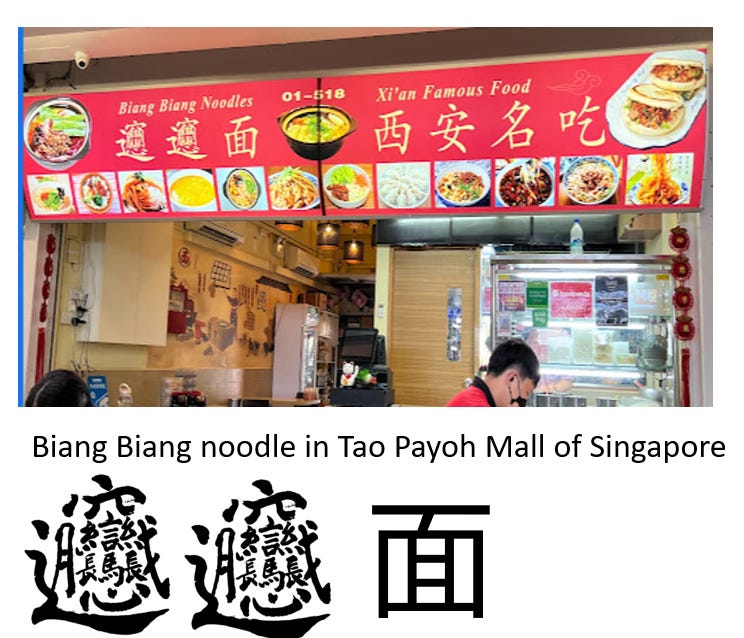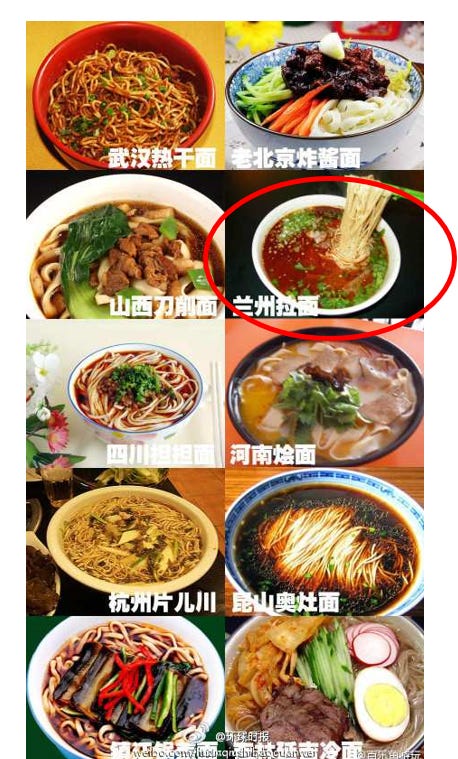#17 The noodle that cannot find itself in the dictionary...
Mandarin is interesting as many Chinese characters embody historical elements that depict the Chinese civilisation for a few thousand years and so learning the language helps one to know China better.
Chinese language is fascinating because the ancient Chinese used pictogram initially for communication purpose. Though many Chinese characters have been simplified, you could still see some remnants of pictogram as about 97% of Chinese characters are of the “semantic-phonetic compound” type (形声字). In essence, semantic-phonetic compound offers clues in the sound and representation of the Chinese character.
Many foreigners find Chinese language daunting but there are alway productive/innovating ways to learn it and today I want to highlight one method - mnemonics by looking at biang biang noodle or biáng biáng noodle if you include the tone.
Above image of biang biang noodle is the screengrab of well-known instant noodle ranking website “The Ramen Rater” and the noodle was listed in the list of top 10 instant noodles in 2019 by the website. But it does look complicated with many strokes but fret not, I will guide you on how to write it step by step.
The character biáng actually became a hot discussion topic on Reddit some months ago due to its “infamous” distinction as the most complex Chinese character with 66(!) strokes (based on the below version as there are a no. of different versions).
I could not type it out on the computer as it is not a recognised character in the dictionary. It is only present in a famous Shannxi/Xi'an delicacy known as biang biang noodle. This is one such hawker selling it in even in Singapore, do see below.
How do you write such a character? There are some 口诀(kǒujué) which is like a mnemonic that tells you how to write biang in order and below is one such popular mnemonic . I think it is actually good for Mandarin learners to practise writing it as the words in the mnemonic would help you to improve your Chinese when you use them in writing. Do note that some traditional characters are required to write this complex character.
Mnemonic
“一点飞上天,黄河两边弯;八字大张口,言字往里走,左一扭,右一扭;西一長,东一長,中间加个馬大王;心字底,月字旁,留个勾搭挂麻糖;推了车车走咸阳.”
Translation and explanation of the mnemonic:
🔹[丶] 一点飞上天 (one dot flies into the sky)
🔹[冖] 黄河两边弯(the Yellow River bends on both sides)
🔹[八] 八字大张口 (the character eight 八 opens its mouth)
🔹[言] 言字往里走 (the character 言 {words} walks into the inside)
🔹[糹]左一扭,右一扭 (make a twist on the left, make a twist on the right)
糹is the traditional radical that means silk and it has become 纟in simplified form.
This phrase actually comes from the Shannxi language itself as 糹as a radical is referred as 絲扭 there while it is known as 絞絲 in other parts of China. 絲 was the traditional character for silk and so 糹and 絲 are the same in meaning.
絞絲 means to twist 絞 the silk 絲 which is known as skein twisting in silk production. 絲扭 is similar to 絞絲 as 扭 means twisting too. Thus 扭 refers to 絲扭 and so you have to add 糹on both sides of 言.
🔹[長] 西一長,东一長
Adds the character 長 (长 in simplified form) which means long on the west and east sides.
🔹[馬] 中间加个馬大王
Insert the King Horse 馬(马) in the middle.
🔹[心, 月]心字底,月字旁
Add the heart 心 at the bottom 底 with the moon character 月 at the side 旁.
🔹[戈]留個勾搭掛麻糖
Leave a 勾搭 ( Shannxi word meaning hook i.e.戈) behind to hang the sesame candy 麻糖
If you look at the word in the Reddit case which is the common version you find nowadays, it actually differs from 戈 as it is replaced by 刂(the knife radical). This looks like a simplified version of the character but 戈 should be authentic as you cannot hang sesame candy on a knife. The State Council Information Office (SCIO) website also uses 戈 instead of 刂.
🔹[辶] 推了车车走咸阳
Push the cart 车车 and walk (辶) to Xianyang city. 辶 as a radical which means walking.
Origin
Based on the study by some scholars, it does seem that the character itself is an encapsulation of the Shannxi culture of a seller using a one-wheeled vehicle 独轮车 for trade and hence it is so complex.
For e.g., "东一扭,西一扭” could mean "车夫推车走路时左右扭动以保持独轮车平衡" (see State Council Information Office (SCIO) website again) which highlights the seller twists the one-wheeled vehicle left and right when walking to keep it balanced, hence 糹was used to represent such action.
I think the biang character is too narrowly-defined and so it had been discarded over time. But because the noodle was named after it, so it manages to survive in this modern era.
=========
Side Note : Ramen
One should take note that Ramen (拉麵) means Chinese noodle from the perspective of Japanese as highlighted above from its Wikipedia. This is because the noodle was imported into Japan which did not have this noodle that had such texture, thickness etc. Because it was not originated in Japan, so Ramen was loanword from China i.e. 拉面 lamian and so ラーメン is in katakana script.
But in China, there are many types of noodles as shown above and 拉面 is only one of them and one famous lamian dish is Lanzhou Lamian 兰州拉面. Therefore although 拉面 (China) and 拉麺 (Japan) are similar Chinese character (面 is the simplified form of 拉麺), they do not share the same meaning. Incidentally, the 拉 means to pull as one has to stretch the kneaded dough.
So instant noodle is not known as instant ramen 拉麺 in China, Hong Kong and Taiwan:
China : 方便面、泡面
Hong Kong : 泡面、速食面
Taiwan 公仔面、即食面
As an illustration, 泡 pào means to soak since instant noodle is convenient because one just needs to add hot water to soak it and voilà!, your growling stomach has found a saviour!






